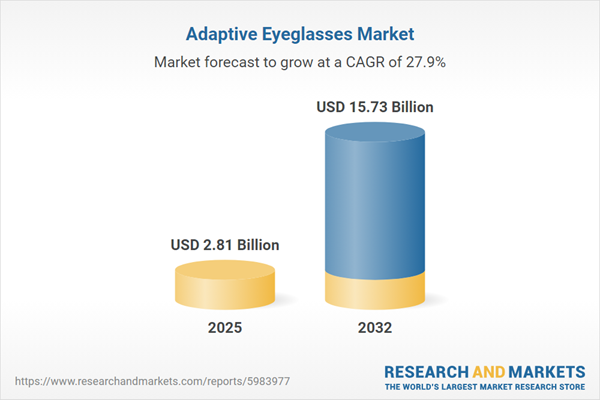Increasing Integration with Telemedicine and Digital Health Solutions Present Lucrative Business Opportunities
Speak directly to the analyst to clarify any post sales queries you may have.
The adaptive eyeglasses market is in a phase of rapid transformation, driven by advanced smart lens technologies and heightened demand for personalized vision correction. Businesses in this evolving sector are leveraging innovation to deliver adaptive eyewear solutions that anticipate user needs, elevate comfort, and blend seamlessly into daily life.
Market Snapshot: Adaptive Eyeglasses Market Growth
The Adaptive Eyeglasses Market grew from USD 2.19 billion in 2024 to USD 2.81 billion in 2025. With a projected CAGR of 27.92%, the sector is expected to reach USD 15.73 billion by 2032, underscoring significant growth opportunities for stakeholders.
Scope & Segmentation
- Technology: Electrochromic Lenses (Polymer Dispersed Liquid Crystal, Suspended Particle Device), Photochromic Lenses (Organic Photochromic, Silver Halide Photochromic)
- End User: Adults, Children, Seniors
- Prescription Type: Bifocal, Progressive, Single Vision
- Distribution Channel: Department Stores, Hypermarkets Supermarkets, Online Retail, Optical Shops
- Price Range: Mid, Premium, Value
- Product Type: Full Rim, Rimless, Semi Rimless
- Regional Coverage: Americas (United States, Canada, Mexico, Brazil, Argentina, Chile, Colombia, Peru), Europe, Middle East & Africa (United Kingdom, Germany, France, Russia, Italy, Spain, Netherlands, Sweden, Poland, Switzerland, United Arab Emirates, Saudi Arabia, Qatar, Turkey, Israel, South Africa, Nigeria, Egypt, Kenya), Asia-Pacific (China, India, Japan, Australia, South Korea, Indonesia, Thailand, Malaysia, Singapore, Taiwan)
- Companies Analyzed: Adlens Global Limited, Deep Optics Ltd., Johnson & Johnson Vision Care, Inc., FocusSpecs, Inc., Eyejusters Ltd., Eyekraft Oy, Smart Vision Labs, Inc., EyeSwitch Ltd., Optotune AG, Opteev Technologies Inc.
Key Takeaways for Decision-Makers
- Smart lens innovation is expanding, with electrochromic and photochromic technologies offering solutions tailored for varying environmental and user-specific demands.
- Adaptive eyeglasses are evolving into multifunctional devices, featuring integrated sensors for health monitoring, augmented reality overlays, and enhanced user comfort.
- Collaborations between manufacturers, material scientists, and electronics specialists are central to advancing power efficiency and reducing form factor in next-generation eyewear.
- Sustainability is gaining ground; eco-conscious consumers are seeking products built with recyclable frame materials and sustainable lens components.
- Segmented offerings address unique requirements across end users, prescription types, and channels, increasing market penetration and end-user satisfaction.
- Regional strategies are essential to navigate regulatory requirements, purchasing behaviors, and competitive landscapes across key markets including North America, EMEA, and Asia-Pacific.
Tariff Impact
The 2025 adjustment of United States tariffs is reshaping importation costs and global supply chain strategies for adaptive eyeglasses. Industry response includes dual-sourcing, automation in domestic production, and investment in advanced inventory management. These actions improve resilience and foster strategic flexibility in addressing cost and distribution challenges.
Methodology & Data Sources
This report draws on qualitative interviews with industry experts, detailed secondary research of standards and compliance, and cross-validation with market data. Review of patent filings, trade data, and collaborative workshops ensures reliability and up-to-date insights for senior decision-makers.
Why This Report Matters
- Facilitates strategic planning by clarifying the technological and regulatory shifts impacting adaptive eyewear markets.
- Enables executives to identify emerging opportunities by segment, region, and distribution model to optimize portfolio development.
- Supports informed investment in sustainability, supply chain resilience, and user-centric innovation with actionable intelligence.
Conclusion
Adaptive eyeglasses represent a dynamic intersection of technology and user preference. This report empowers stakeholders with clarity on market drivers and risk factors, supporting effective, strategic growth decisions in this evolving sector.
Additional Product Information:
- Purchase of this report includes 1 year online access with quarterly updates.
- This report can be updated on request. Please contact our Customer Experience team using the Ask a Question widget on our website.
Table of Contents
3. Executive Summary
4. Market Overview
7. Cumulative Impact of Artificial Intelligence 2025
Companies Mentioned
The companies profiled in this Adaptive Eyeglasses market report include:- Adlens Global Limited
- Deep Optics Ltd.
- Johnson & Johnson Vision Care, Inc.
- FocusSpecs, Inc.
- Eyejusters Ltd.
- Eyekraft Oy
- Smart Vision Labs, Inc.
- EyeSwitch Ltd.
- Optotune AG
- Opteev Technologies Inc.
Table Information
| Report Attribute | Details |
|---|---|
| No. of Pages | 180 |
| Published | November 2025 |
| Forecast Period | 2025 - 2032 |
| Estimated Market Value ( USD | $ 2.81 Billion |
| Forecasted Market Value ( USD | $ 15.73 Billion |
| Compound Annual Growth Rate | 27.9% |
| Regions Covered | Global |
| No. of Companies Mentioned | 11 |









